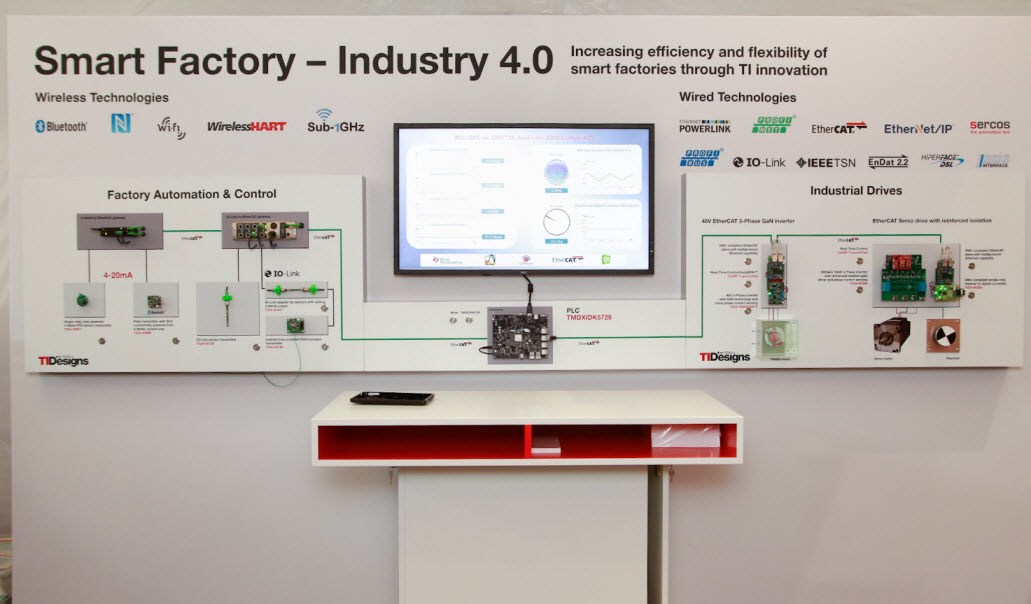SSZTAO2 november 2016 LMG5200

Today’s end-equipment markets demand shorter product life cycles, more individually configured products and fast adaptation to quickly changing consumer interests. On the manufacturing floor, key parameters include lower resource utilization, especially less power, faster manufacturing and lower production downtimes. These requirements necessitate a more sophisticated, smarter factory that leverages the cloud and uses remote big-data analysis capabilities to optimize and adapt the manufacturing process flow, increasing the ability to track the product across its complete life cycle.
The connection of machines and production cells to the internet enables a real-time view of process data. The connection of machines to the product also gives a real-time view of product data. Automated machines and production cells operated by industrial service robots handle raw material and production parts. Product and machine quality checks occur during the production process to further shorten cycle times. Human interactions are reduced and focused on higher-value tasks within the production process.
Breakthroughs in innovation are making Industry 4.0 a reality. And much of the technology that is marking a significant difference is enabled by engineering companies like Texas Instruments. It’s critical for TI to solve subsystem design challenges that will improve smart manufacturing design, including efficiency and flexibility, while providing a real-time view of manufacturing processes, connectivity and communications.
Here are some of the key technologies of Industry 4.0 leading to smarter, more efficient manufacturing:
- Compatible industrial
communications. In order to get a transparent view of the complete
manufacturing system, all data must be available through industrial communication technologies that share a
common format. You’ve likely heard the phrase, “IT connects to the OT.” This
means that the Information Technology (IT) world uses the internet protocol (IP)
and higher-layer protocols for secure web access. The Operational Technology
(OT) world uses dedicated field bus and Industrial Ethernet, which often uses only the
Ethernet standard but not software-based networking stack components. This
incompatibility between the field level and enterprise level requires a
compatibility layer defined as part of the Industry 4.0 framework. An Industry
4.0 gateway with an Open Platform Communications Unified Architecture (OPC UA)
connection to higher layers and a field-bus connection to lower layers is a
short-term solution to the compatibility problem.
Extending the communication to the product level requires low-power communication. Radio-frequency identification RFID is a key technology for getting products and machines talking. With sensors deployed near the product and at the machine, the power supply is through a cable. IO-Link standardizes the extension of basic on/off status communication with a bi-directional digital communication. The IO-Link gateway talks directly to OPC UA using either industrial Ethernet or wireless LAN. For manual operator inspections, a Bluetooth® low energy connection sends the data to a mobile terminal.
- Highly accurate sensing.
The efficiency of the production process depends heavily on industrial sensing technologies. Machine tool setup
time for smaller quantities becomes more important. Collision avoidance between
tools, work pieces and fixtures can be simulated offline, although an online
collision avoidance system will still be required. Many materials and tools
require water cooling, which makes it difficult for optical sensors to detect
collisions. Scanners that work in dusty and moist environments are required.
Tools are subject to failure and a loss of production quality over their lifetimes. Continuous force sensing of the tool can provide an early indication of a tool break. Tool quality can impact data from temperature sensors and acoustic sensors. Predictive maintenance is a buzz phrase that describes the concept of using early indicators of a tool break to replace tools at an early stage, with no impact to production flow or production quality.
The multi-axis control of a machine tool uses closed-loop motion to position a router or material. The tolerance on size and surface has additional variance that comes from mechanical variances of the axis, tool and fixture. Precision distance measurement using linear encoders and laser distance sensors are used for machine calibration, motion control and quality monitoring.
The manufacturing process depends on environmental data such as temperature and humidity. Active cooling and cleaning systems have an impact on environmental conditions. Flow sensors for liquid and air provide the input for the environmental systems of a machine tool.
- Motor drive and control
efficiency. Motors are the components that require most of the energy in
a production system. Frequency variable drives with closed-loop current, speed
and position control enable a dynamic torque profile that has a direct impact on
power consumption. High-precision current
measurement over isolation and rotor-position measurement through
absolute encoders feed the control algorithm for
every control cycle. Besides an efficient motor-control algorithm, the
efficiency of the power stage is a key contributor to power consumption. The
faster switching frequency of gallium nitride (GaN) transistors reduces the power
of motor-drive systems in a production cell.
A modern production cell has four major subsystems which work together: the computer numeric control (CNC) system that defines the overall production process, the motion-control subsystem driving the motors and actuator for production, the programmable logic control (PLC) system for additional sensing and control applications, and a service robot for material handling.
- Embedded processing. Increasing the efficiency and flexibility of a production system has many aspects. Industrial communication, industrial sensing and industrial control build the foundation of a smart factory. Local intelligence runs on embedded microcontrollers and microprocessors. Extracted product and process data are sent to the industrial cloud for big-data analysis through wireless and wired industrial communication.
Industry 4.0 Demonstration Wall
We are showing off several industrial demos that are helping to enable Industry 4.0 and the smart factory of tomorrow leveraging TI semiconductor solutions. Come by the TI booth (Hall A4, Booth 219) at electronica 2016 and SPS Drives (booth #6-441) to see for yourself. But here’s a sneak peek at what we plan to show.
TI’s Industry 4.0 demonstration wall will feature the latest TI reference designs and innovation to enable real-time Ethernet communication capability with an EtherCAT gateway. We are featuring sensor communications with wired technologies like IO-Link and wireless technologies such as Bluetooth® low energy. And TI’s GaN technology is on display with a 48-V 3-phase GaN-based inverter with current sensing to help increase efficiency in variable speed motor drives.
 Figure 1 TI Demonstration Wall Highlighting Innovation in Industrial Motor Drive
Control
Figure 1 TI Demonstration Wall Highlighting Innovation in Industrial Motor Drive
ControlHere are more details about each reference design featured on TI’s Industry 4.0 demo wall, available for download on TI.com.
Factory Automation and Control:
- Field transmitter reference design with BLE connectivity powered: This field transmitter design measures humidity and temperature. It broadcasts the measured values with Bluetooth® low energy. The design is loop-powered from 4 to 20-mA current, and the current value on the loop is changed according to the humidity value.
- IO-Link sensor transmitter reference design: This reference design offers a rapid prototyping platform for IO-Link sensor transmitter. Thanks to its modular design, different sections can be easily cut to allow fast and simple interfacing of any analog or digital sensor.
- Single-chip, loop-powered 4-20mA RTD sensor transmitter reference design; The built-in processor in this design enables the usage of compensation algorithms, increasing the system performance. The reference design is ideally suited for space-constrained applications, and operates at high ambient temperatures with low-power performance.
- IO-Link adapter reference design for sensors with analog 4-20mA output: This design evaluates the binary or analog 4-20mA output signal of sensors in the industrial environment and forwards the results to the PLC via IO-Link. All this is fitting in a 6mm-wide PCB compatible with an industry standard M12 connector.
- Isolated loop powered thermocouple transmitter reference design: This reference design system solution provides precision K-type thermocouple measurements for 4 to 20-mA isolated current-loop applications. The solution helps designers quickly prototype and develop end-products for process control and factory automation.
Industrial Motor Drives:
- Reference design for reinforced isolation: 3-phase inverter with current, voltage and temp protection. Implement a power stage that provides superior reinforced isolation capability and reduced switching losses.
- EMC-compliant single-chip resolver-to-digital converter (RDC) reference design: This solution reduces system cost and board space compared to traditional RDC solutions and provides on-chip protection and diagnostics to improve robustness against short-circuit and increases safety by detecting external fault conditions.
- 48-V 10-A three-phase high-frequency Gallium Nitride (GaN) based inverter for brushless motors reference design: TI combines its LMG5200 half-bridge GaN power module with a faster, more accurate current sense amplifier to create a reference design that enables more efficient, smaller motor designs.
- Shunt based in-line phase current sensing with 48V 3-phase inverters: In-line phase shunt based current measurement allows continuous phase current measurement for better drive performance and high AC common mode rejection allows precision current sensing from low-high PWM frequencies, along with high gain and offset accuracy over entire temp range without calibration.
- EMC-compliant EtherCAT slave with multiprotocol Ethernet capability: This reference design provides ultimate flexibility with multiprotocol Ethernet capability, including a dual port EtherCAT slave with HW option for PROFIBUS and multi-protocol RT Ethernet. It also includes a cost-optimized power management IC to supply entire board and is designed to meet IEC61000-4-2, 4-4 & 4-5 EMC immunity.
Additional Resources:
- New white paper: Making factories smarter, more productive through predictive maintenance by TI's Avner Goren and Miro Adzan.
- More information and reference designs related to Industry 4.0.
- TI products and subsystem design expertise for Factory Automation and Control and Motor Drives.
- Read the blog Control-level design challenges in smart factory automation systems.